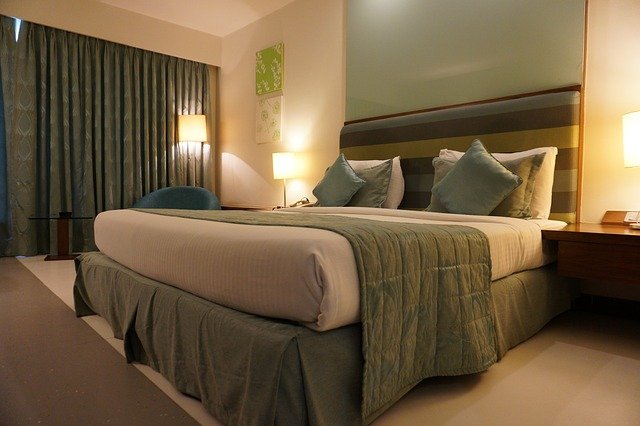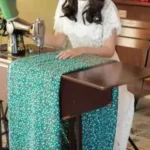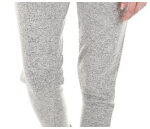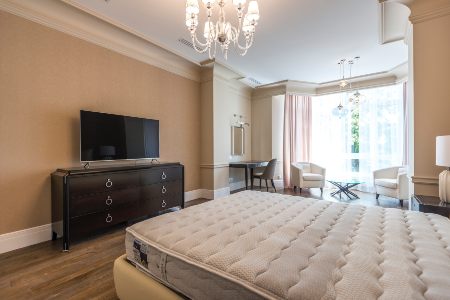Are you planning to purchase new curtains but are not yet sure the type of curtain you will buy. You have probably considered; rod pocket curtains, eyelet curtains, tab-top curtains, pleated curtains, window scarf curtains, cafe curtains, sheer curtains, and even blackout curtains, but you are unsure what kind of curtain to buy.
In this article, we look at blackout curtains in great detail. By reading this article, I hope that you will have a better understanding of what a blackout curtain is and the various features of this type of curtain.
What Are Blackout Curtains?
Blackout curtains comprise drapes made of a double-lined and tightly woven fabric. The main feature of blackout curtains that make them different from other curtains is that they can ensure that light is completely blocked. Thus, in a room with blackout curtains, light only gets in the room through the gaps around the window but not through the curtains.
Even though there have been concerns that chemicals making fabric used to make blackout curtains can be toxic to human beings, the chemicals pose no risk to people’s health as long as the curtains are well maintained.
Blackout curtains are commonly used in hotel rooms, bedrooms, nurseries, and media rooms.
What are the Pros and Cons of Blackout Curtains?
Before you buy blackout curtains, I recommend that you first understand the pros and cons of these curtains so that you can make an informed decision on whether to buy them or not.
Pros of Blackout Curtains

Blackout Curtains Help Save Energy; Thus Helping Protect The Environment
The main reason for using blackout curtains is to ensure that there is no light and, in some cases, no sunlight gets in the room. When the curtains ensure that minimal sunlight gets inside the room during the summer season when there is a lot of the sun, there is no need to use an air conditioner. As such, a lot of energy that the air conditioner would have used ends up being saved.
Blackout Curtains Enhances Kid’s Safety
When contrasted with other types of curtains, blackout curtains are a safe option for kids since they do not have any drawstrings or cords, which can have devastating impacts. For example, a child could suffocate if he was to tie a cord or a drawstring to his neck. However, with blackout curtains, that risk is non-existent.
Blackout Curtains Helps Reduce Noise Inside A House
Since blackout curtains are thick, they can absorb some of the heat from the outside. As such, they make the room quiet to some extent. For that reason, in areas with high noise levels, blackout curtains are used as they are known to help soften the noise coming from the outside. Moreover, this is also one of the reasons why blackout curtains are typical in many hotels around the world.
Blackout Curtains Enhances Privacy
As the word ‘blackout’ suggests, blackout curtains do not allow any light to come inside the room or go out unless there are gaps between the window and the curtains. Thus, they help enhance privacy as one can be in the room and have the lights turned on while those outside the room will think that there is no one in the room as they cannot see any light from the windows.
Protects The Room From Fading Caused By Sunlight
When the sunlight is extreme, it causes damage to different items that comes into direct contact with it. For example, when a piece of furniture is subject to a lot of sunlight for an extended period, the sunlight will cause the fabric of the furniture to fade with time. However, when the room has a blackout curtain, the sunlight cannot damage the furniture in the long run.
Cons Of Blackout Curtains

When Excessively Used, They Can Have Negative Impact On Health
Blackout curtains shield natural light from getting inside the room. Thus, when one stays in a room with blackout curtains for long, the person will not come into direct contact with natural light and sunlight.
As we all know, natural light and sunlight are essential to the health of human beings. Thus, by blocking natural light and sunlight, blackout curtains have the potential to harm the health of people.
Can Result To High Costs Of Power
Even if blackout curtains help save air conditioner energy costs, as already pointed out, the curtains, on the other hand, require light bulbs to be switched on at all times. Thus, unless in situations where the blackout curtains are only used at night, these curtains could result in high costs of power being incurred.
Blackout Curtains Could Be Expensive
Due to their light-blocking feature, blackout curtains can be expensive in the long run. Moreover, since a solid and heavy-duty fabric is used to make the curtains, if you want to replace other curtains in the room, you might have to modify curtain rods so that they can hold the heavy blackout curtains. Such modifications involve added costs which makes the curtains more expensive.
Are Blackout Curtains Able To Keep Heat?
Blackout curtains minimize the amount of heat transferred through the window by about 25%. By doing that, the curtains keep the rooms cooler during the summer season and warmer during summer.
Thus, If you wonder whether blackout curtains block heat, then the answer is yes since they stop heat from the outside (sun) from coming into the room while also blocking the heat inside from escaping through the window.
Can You Dye Blackout Curtains?
Yes, you can dye blackout curtains. However, the success or failure of your dyeing endeavors will be determined by the fabric and the color of the blackout curtains.
When you want to dye blackout curtains, it is essential that you first understand the fabric used to make the curtains. Specifically, if your blackout curtains are made with natural fabrics such as cotton, you will be able to dye them. However, suppose the curtains are made from synthetic material. You might find it challenging to dye the fabric – synthetic fabrics do not have an excellent ability to hold the dye.
As far as the fabric’s color is concerned, you will not be able to dye the blackout curtain if it has a very dark shade/color. However, most blackout curtains nowadays come in white or off-white colors and are made with poly cotton fabric coated with a few layers of acrylic so that the light is blocked.
Since acrylic is a synthetic fiber, you cannot use standard dyes to dye your blackout curtains. The two dyes that will work with acrylic fabrics are disperse dye, mainly used to dye polyester, and basic dye. You can buy these dyes from online stores.
How To Dye Blackout Curtains
What You Will Require
- Nylon piece of cloth
- Mild detergent
- Disperse dye
- Dye carrier
- White vinegar
- Hot water
- A medium-large pot
- Protective clothing – gloves, face masks, apron, etc.
- Stove
- Spoon
- Measuring units
- Waterproof thermometer
- 2 large basins made from stainless – steel
- Your blackout curtains to be dyed
- Well ventilated working area
Overview Of Acrylic Fabric used in Blackout Curtains
Acrylic fabric is also known as Courtelle, Nitron, Orlon, and Leacryl. This fabric is loved because it is light, warm, dries quickly, and maintains its shape for a long time. To dye acrylic fabric, either disperse or basic dye has to be used. If ordinary dyes are used, the result will not be impressive. In the dying process, high temperatures are needed in the chemical carrier to ensure that the dye is dispersed inside the fabric.
Step 1: Preparation
In this step, you will ensure that you have everything you need to dye the blackout curtains. If you undertake dying inside a room, you will need to make sure that the windows are opened and that the room is well ventilated.
Step 2: Wash the Blackout Curtains To Be Dyed
This step is only to be undertaken if your blackout curtains are dirty. Then, you will either hand wash or use a steamer to wash the curtain.
Step 3: Wear The Protective Clothing
Put on protective clothing to make sure you have protected yourself. Make sure you wear your face mask, apron, and hand gloves.
Step 4: Mix The Dye
You will add the dye you are using (basic dye or disperse dye) to boiling water. Please refer to the instructions given by the manufacturer of the dye to find out the correct ratio of dye to hot water. Stir the mixture of the dye and water with the spoon.
Step 5: Let The Dye Mixture Cool To Room Temperatures
Leave the dye for some time so that it cools to room temperature. The room temperature, in this case, should be 25-28 degrees Celsius. Once the mixture has cooled down, you will sieve the mixture through the nylon piece of clothing.
Step 6: Mix the Mixture Sieved In Step 5 With Hot Water
Following the guidelines given by the dye manufacturer, you will add hot water to the stainless-steel basin. Next, add the mixture you sieved in step 5 to the basin. You will then add detergent and white vinegar. After that, add the dissolved dye and the carrier of the dye. You will then use the spoon to stir until everything is mixed together.
Step 7: Put The Blackout Curtains Into Basin and Place It On Fire
You will now put the blackout curtains on a stainless-steel basin with the mixture. After that, place the basin on top of the fire and let the mixture boil as you continuously stir. Let the mixture stay in the fire for about half an hour while you also stir occasionally. Then, take away the mixture from the fire. Next, pour water into the other stainless-steel basin and place this basin on fire.
Step 8: Remove the Blackout Curtain From The Dye Mixture and Put In Basin With Clean Hot Water
You will now remove the blackout curtain from the mixture with dye and put it in the other stainless steel basin with hot clean water. You must ensure that the water in the second basin has reached boiling point. If the water has not reached the boiling point, some dye carriers in the blackout curtains will not be removed, and the curtain will also have an unpleasant smell.
Step 9: Rinse The Dyed Blackout Curtain
Put hot water in the basin. Put your dyed blackout curtain and stir for at least 10 minutes. You will then rinse the blackout curtain to ensure that all the chemical components of the dyeing process have been removed.
If you notice that the freshly dyed blackout curtain still has some smell, you can rinse the curtain a couple of times by repeating step 9 two or three times.
Step 10: Hang The Dyed Blackout Curtain To Dry
Once you have rinsed the dyed blackout curtain, you then hang it so that it dries and airs well. After that, your blackout curtain is available to use.
Can You Wash Blackout Curtains?
Yes, you can wash your blackout curtains to keep them clean. There are four different washing methods that you can use to wash the fabrics. These methods comprise; handwashing with soap, dusting and vacuuming, detergent, and steam.
For handwashing with soap, you will soak the curtains in water with soap and wash them with your hands. Take note that if you wash the blackout curtain with a washing machine, the curtain will be damaged as the coating will be cracked.
You can use a soft brush or feather duster to remove any dirt from the blackout curtain for the dusting and vacuuming cleaning method. You will then use a small fabric vacuum cleaner and clean the curtain to remove any dust.
For cleaning with detergent, you will clean the sections or spots of the curtain with dirt. You will put water in a basin and add detergent. Then, with a soft cloth or a sponge, you will use the water with detergent to clean the spots that are dirty. The main benefit of this method is that you do not need to take the blackout cotton down.
To steam clean the blackout cotton, you will use a steamer. After turning on your garment steamer and starting to produce steam, clean the curtain from top to bottom. Be careful that you do not soak the curtain. So, for those who ask whether blackout cotton can be steam cleaned, yes, it can be steamed.
Do Blackout Curtains Block Heat?
Yes, blackout curtains block heat in two ways. The first way is by ensuring that the heat inside the room does not get out, while the other way is by ensuring that no heat from the outside gets inside the room. Thus, blackout curtains can block heat.
Do Babies Need Blackout Curtains?
Yes, babies need blackout curtains. Specifically, these curtains are needed by babies since they help block light and noise, thus making it easy for babies to sleep. Therefore, nurseries need to have rooms with blackout curtains so that babies can settle down and sleep for long periods.
Final Thoughts
Blackout curtains are perfect for rooms that do not require either natural light or sunlight to get inside the room. The curtains can be hand washed if they get dirty or cleaned with steam. However, if reasonable care is taken to the curtains, you will not need to wash the curtains for a very long period. If you want to dye a blackout curtain, you can use the elaborate procedure that I have detailed in the article.







